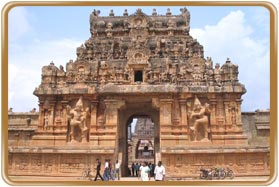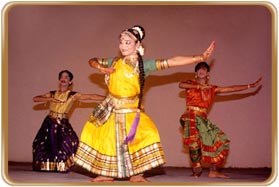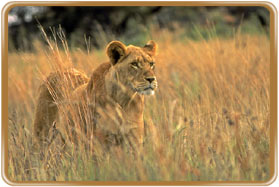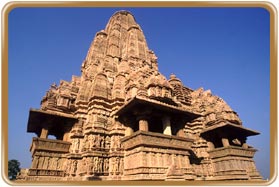 Tamil Nadu is home to more than 30,000 temples and is aptly called "the land of temples". The rulers of various dynasties constructed these temples over centuries. Tamilnadu is the land where Dravidian style of temple architecture manifested itself in a grand and magnificent way. Vimanas (storeys) andGopurams (towering gateways to the temple complex) best characterize the temples of Tamilnadu. You will be amazed to see that most of these temples bear a superficial architectural resemblance with each other as they share the similar physical features- Gopurams (the imposing tower over the entrance, from all four directions) and the Vimana (the tower over the sanctum). It is interesting to note that the temples of South India were not merely a place of worship but a large part of social and cultural life of the people revolved around them.
Tamil Nadu is home to more than 30,000 temples and is aptly called "the land of temples". The rulers of various dynasties constructed these temples over centuries. Tamilnadu is the land where Dravidian style of temple architecture manifested itself in a grand and magnificent way. Vimanas (storeys) andGopurams (towering gateways to the temple complex) best characterize the temples of Tamilnadu. You will be amazed to see that most of these temples bear a superficial architectural resemblance with each other as they share the similar physical features- Gopurams (the imposing tower over the entrance, from all four directions) and the Vimana (the tower over the sanctum). It is interesting to note that the temples of South India were not merely a place of worship but a large part of social and cultural life of the people revolved around them.Temple Architecture
The temple architecture in Tamilnadu grew with innovation and experiments. The rule of the Pallavas, Pandyas, Cholas, Vijayanagar rulers and the Nayakas saw the construction of a number of magnificent temples. Thousands of temples, with rising towers that touch the skyline of Tamil Nadu, were constructed during the reign of the above-mentioned empires. These temples demonstrate that the Tamils have been the most innovative temple builders. This fact is very well evident in the temples from the pre Christian era as well as those from the 20th century. The spectacular architecture of these temples inspires awe and amazes the onlookers.
Most of the ancient temples of Tamilnadu were constructed in brick and mortar. However, by the 7th century AD a unique style of temple construction emerged when temples were hewn out of caves. The rule of the Pallavas saw (up to 900 AD) building of temples of stone. The Cholas (900 -1250 AD) were great temple builders and they have a number of magnificent and spectacular to their credit. The Brihadeeswarar temple in Thanjavur, built by Raj Raja I, is a tribute to the Chola rulers. The Chola rulers added many ornate mandpams (halls) to temples and built large gopurams (towers). Subsequently, the Pandya Style (Up to 1350 AD) saw the emergence of the temple architecture with huge towers, high wall enclosures and massive gateways. The Vijayanagar rulers also made significant contribution to the temple architecture. They are known more for the intricacy and decorated monolithic pillars.
As you travel across the state of Tamilnadu, you will be awestruck and amazed to see the intricately carved designs and the splendid architecture of the temples spread over the length and breadth of the Tamil land.
Airavatheeswara Temple
The temple architecture reached its zenith during the rule of the Chola rulers. Thanjavur, being the capital of the Chola rulers, witnessed most of the architectural activities.
Brihadeswara Temple
The Brihadeswara temple is one of the most ancient and the most celebrated Hindu temple in the world. The temple is located in the city of Thanjavur that is also known as Tanjore, in the Indian province of Tamilnadu.
Kailasanath Temple
Kanchipuram is a pilgrimage city. A former Pallava capital (7th - 9th century), Kanchipuram is filled with temples dating from the 8th - 17th centuries.
Kanyakumari Temple
Kanyakumari forms the southern most end of mainland India. It is also the place where the Arabian Sea, the Bay of Bengal and the Indian Ocean merge.
Mahabalipuram Rathas
Mahabalipuram is a temple town that is situated along the Coromandel Coast 55 kilometers off Chennai, the capital of Tamilnadu. The place is famous for its Ratha temples that are a part of the famous shore temple complex.
Meenakshi Temple
The Meenakshi temple complex is one of the largest in India. The presiding deity at the Meenakshi temple at Madurai, the Athens of South India, is Goddess Meenakshi. The nucleus of the temple is older than the Madurai city.
Murugan Temple
The Murugan temple at Tirupporur is one of the major temples dedicated to Lord Muruga in Tamilnadu. The Murugan temple is situated at a distance of about 45 Km from Chennai.
Rameshwaram Temple
The Ramanathaswamy Temple is one of the most sacred shrines of the Hindus in India. The Jyotirlingam at the Ramanathaswamy temple is the southernmost of the 12 Jyotirlingams of India.


 emotion and the spirit of improvisation, it also contains a scientific approach. This is mainly due to the contributions of such inspired artists as Purandara Dasa, known as the Father of Carnatic Music, and other scholars who codified the system and gave it a clear format as a medium of teaching, performing, prayer and therapy.
emotion and the spirit of improvisation, it also contains a scientific approach. This is mainly due to the contributions of such inspired artists as Purandara Dasa, known as the Father of Carnatic Music, and other scholars who codified the system and gave it a clear format as a medium of teaching, performing, prayer and therapy.

 The history of Tamil Nadu is very old and goes back to thousands of years back. It is believed that the Dravidians of Tamil country were once a part of the early Indus Valley settlers and moved south after the advent of the Aryans around 1500 BC. However, the recorded history of human civilization in Tamil Nadu goes back only to the 4th century BC. The Sangam literature has several references to the social, economic and cultural life of people in this part. The close proximity to the Sea put the Tamil Country on the maritime map of the world even before the dawn of Christian era. Over a period of time, the Tamils developed trade links with ancient Egypt, Greece and Rome.
The history of Tamil Nadu is very old and goes back to thousands of years back. It is believed that the Dravidians of Tamil country were once a part of the early Indus Valley settlers and moved south after the advent of the Aryans around 1500 BC. However, the recorded history of human civilization in Tamil Nadu goes back only to the 4th century BC. The Sangam literature has several references to the social, economic and cultural life of people in this part. The close proximity to the Sea put the Tamil Country on the maritime map of the world even before the dawn of Christian era. Over a period of time, the Tamils developed trade links with ancient Egypt, Greece and Rome.